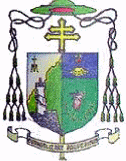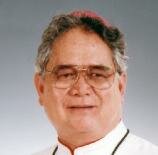The Catholic Bishops' Conference of the Philippines
The Official Website of
CBCP Online

The pastoral activities are centered on the different apostolates. The Commission on Family Life came up with modules to celebrate the Year of the Family in the parishes of the archdiocese. it also organized highly successful pro-life rallies.
The Commission on Education, chaired by the Archbishop, met with all principal teachers and administrators of Catholic schools who also compose the Commission, to discuss problems pertaining to schools. There is a program for on-going formation, and days of recollection for all the teachers of these schools.
The Archdiocesan
Social Action Apostolate has been completely reorganized. The distribution of relief goods during disasters, and action for the protection of human rights continue to form the core of its activities. Charitable action has been modestly initiated toward disabled children and adults who have Hansen's Disease. Much of the activities of the Social Action Apostolate centers around the formation of people in the performance of their civic duties. This was most evident during the election when the faithful got organized to ensure free and honest elections.
A Commission on Tribal Filipinos has been organized to look into the welfare and interests of many Subanons, a group of tribal Filipinos who have already been converted to Christianity but who still retain their culture and live in the mountains, where they have been pushed back by lowlanders who are mostly Christians.
The Care of Earth Ministry makes up the Commission on Ecology which the Bishops of the Philippines mandated to be organized in their Pastoral letter on Ecology of 1987. This is now operational in the Mount Malindang National Park, a mountain range running through the middle of the archdiocese.
The Commission on Vocation coordinates the promotion of vocations in the entire archdiocese. The vocation campaigns are targetted toward college graduates and more mature individuals.
Other commissions are those on liturgy, youth, catcchesis, media, health care and the Bible.
This ecclesiastical territory first became a prelature on January 27, 1951, then a diocese on February 24, 1971, and finally an archdiocese on January 24, 1983. It now comprises the civil province of Misamis Occidental and the cities of Ozamiz, Oroquieta (capital of the province) and Tangub. As suffragans it has the Dioceses of Dipolog, Iligan, Pagadian and ' the Prelature of Marawi. Its titular patron is The Immaculate Conception.
The province of Misamis Occidental is located on the eastern tip of the Zamboanga Peninsula in Mindanao. Geographically it belongs with the Zamboangas, but culturally it is part of Northern Mindanao with whom it shares a long history of Spanish influence, and the influence of heavy migration from the Visayan and Luzon islands on the north. The province connects with Zamboanga del Norte on the west, and has a circular coastline that faces Iligan Bay on the east, Panguil Bay on the south, and the Mindanao Sea on the north.
Misamis Occidental once belonged to an entire Misamis Province, and during the Spanish regime this larger province was governed through Cebu. Recollect Missionaries established a mission in this province, and Ozamiz City was once a Spanish settlement. The parish of Jimenez in Misamis Occidental is one of the oldest parishes in Mindanao. Originally named Palila, it was renamed in honor of Father Francisco Jimenez of the Recollect Order. Today Jimenez is a town in the province, and the church built there dates back to 1859.
Ecclesiastically, all of Mindanao originally belonged to the Diocese of Cebu. In 1865 the Diocese of Jaro was erected in Panay, and western Mindanao, including Misamis Occidental, came under the jurisdiction of Jaro. In 1910 the diocese of Zamboanga was created with jurisdiction over all of Mindanao and Sulu. In 1933, however, Pope Pius XII created a second diocese in Mindanao, that of Cagayan de Oro, and Misamis Occidental came under the jurisdiction of the Bishop of Cagayan de Oro.
On January 27, 1951, Pope Pius X11 created part of the Diocese of Cagayan into a separate prelature nullius with the cathedral seat in Ozamiz. It comprised the civil provinces of Misamis Occidental, Lanao del Norte and Lanao del Sur.
On February 17, 1971 Pope Paul VI elevated the Prelature of Ozamiz into a diocese, with the Most Reverend Jesus Varela as its First Residential Bishop. By the same papal bull that erected the Diocese of Ozamiz the two Lanao provinces were constituted into a separate prelature which remained under the jurisdiction of Cagayan de Oro. The new Diocese of Ozamiz now consisted only of the civil province of Misamis Occidental and came under the jurisdiction of the Archdiocese of Zamboanga.
On June 24,1983, Pope John Paul 11 elevated the diocese to become the Archdiocese of Ozamiz, with jurisdiction over the suffragan Dioceses of Dipolog, Pagadian, Iligan, and the Prelat, ire, of Marawi. The resident Bishop of Ozamiz, Most Rev. Jesus Dosado, C.M., was in- stalled as the First Archbishop of Ozamiz on April 10, 1983.
Today the, territory comprising the Archdiocese of Ozamiz, originally entrusted to the Columban Fathers, is practically in the hands of the secular clergy. Ministering to 18 parishes are 30 diocesan and 6 religious priests. Among its Catholic institutions are 2 elementary schools, 16 high schools, and 2 colleges.
|
Diocesan Curia |
|
Clergy |
|
Parishes |
|
Educational Center |
|
Institutions |
|
Statistics |

Archdiocese of Ozamiz

